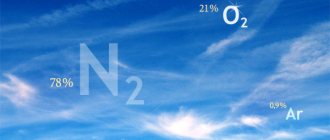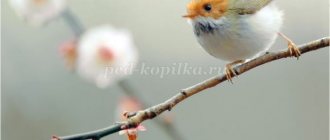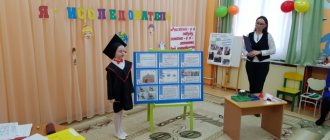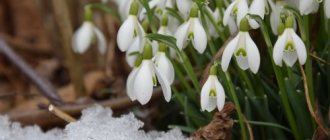Card index of experiments “Snow and Ice”
Target:
Development of creative and cognitive activity of preschool children in the process
research activities.
Tasks:
- Teach children to acquire new information through experimentation.
- To develop children’s ability to observe, draw conclusions and inferences, and then
based on accumulated experience, implement them in independent creative
activities.
- Enrich children's vocabulary.
- Develop cognitive processes (memory, attention, imagination, horizons).
- Develop fine motor skills while implementing creative ideas.
- Develop children’s work and independent skills, sense of teamwork and
responsibility for the work performed.
- Foster activity and a desire to participate in research activities.
- Cultivate an interest in the world around you and a desire to learn something new.
- Cultivate curiosity, love of nature and respect for your health.
Task:
clarify ideas about snow and ice.
Contents of the experience:
Prepare 2 glasses. In one - put snow,
in the other - ice. Find out what color the snow is? Ice?
If children name: white, blue, gray, then show them these colors and compare them with ice.
Result:
The color of snow and ice was determined and compared.
Conclusion:
Snow is white, ice is transparent.
Task:
bring children to the concept of “transparent”.
Contents of the experience:
Prepare a piece of ice and a lump of snow. Place a colored picture under a piece of ice and under a lump of snow. Place a colored picture under a piece of ice and under a lump of snow. Compare where the picture is visible and where it is not. Result:
Under the ice the color picture is visible, but under the snow – not.
Conclusion:
Ice is transparent, and snow is opaque.
Task:
lead children to understand the connection between air temperature and water condition.
Contents of the experience:
Pour clear water into the molds. Add gouache to them. Each mold contains a different gouache. Mix. Take the molds with colored water out into the cold.
Result:
You get beautiful colored pieces of ice (slippery, cold, hard.) Warm the mold in your hands so that the piece of ice pops out more easily.
Conclusion:
Water turns into ice at low temperatures.
Task:
bring children to the understanding that snow melts from any heat source.
Contents of the experience:
Bring snow indoors in a bucket. Watch it melt. Take a little snow on your palm. Also observe the melting process.
Result:
Over time, the snow melts and turns into water.
Conclusion:
From any source of heat, snow melts and turns into water.
Task:
bring children to the understanding that the icicle melts from any heat source (warm room, bright rays of the sun, palm.)
Contents of the experience:
Bring the icicle into a warm room. Place on a tray or palm. Watch her melt.
Result:
Over time, the icicle melts more and more, turning into water.
Conclusion:
The icicle melts from any heat source, gradually turning into water.
Task:
lead children to understand the dependence of the properties of snow on air temperature.
Contents of the experience:
Invite children to make snowballs on a frosty day.
Result:
The snow crumbles easily and sculpting fails.
Conclusion:
In frosty weather, nothing can be molded from snow, because it is light, fluffy, dry, and crumbly.
Task:
clarify the properties of wet snow.
Contents of the experience:
During the thaw, invite children to make snowballs out of snow.
Result:
The snow is molded, beautiful round snowballs are obtained.
Conclusion:
The snow is sticky, heavy, wet, damp.
Task:
determine the properties of snow and ice.
Contents of the experience:
Take a handful of snow and pour it out. What can we call this property of snow? It is advisable to accidentally drop an icicle on a hard surface or knock on it. What happened to her?
Result:
The snow crumbled and the ice cracked.
Conclusion:
The snow is loose and loose. Ice is fragile.
Internet resource used: https://vostochnsad.ucoz.ru/index/0-25
First experiment “Studying the properties of ice”
We poured water into two containers: one had a neck wider than the walls, the other had the opposite. We put both vessels in the freezer.
After some time, we took out the jars and tried to pull out the ice. The piece of ice popped out easily from the wide-necked container, but we couldn’t get the ice out of the second container until it melted to the size of the neck.
Why did this happen? In water, molecules move chaotically, so it takes the shape of the vessel into which it is poured. But unlike ice, water is liquid and can be easily poured out, but ice is the solid state of water. It is impossible to pour solid ice from a jar with a narrow neck until it becomes smaller than the neck.
During this experiment, we also found out that water does not freeze evenly. First, the water freezes at the edges, gradually covering the entire container. We took out the pieces of ice when the middle was not yet frozen, so Nastya made herself an ice ring. (Girls, in one word).
Second experiment: “Does all water freeze equally?”
For this experiment we took two identical jars. Plain water was poured into one, and a few tablespoons of salt were added to the water in the other. Both jars were placed in the freezer.
A few hours later we took out both jars and immediately and unmistakably determined which one contained salt water. Ordinary water froze and turned into a piece of ice, but salt water did not even think about freezing and salt crystals calmly floated at the bottom.
Why did this happen? Different liquids have different freezing points. For example, ordinary water freezes at a temperature of 0 degrees, and for sea water to freeze, the temperature must be 1-2 degrees Celsius.
Precautionary measures
The ice is so cold that it can cause minor burns . Fresh dry ice from the freezer should not touch the skin as it can stick and damage children's delicate skin.
To avoid this, you need to wet the ice or leave it out of the freezer for a few minutes until the ice block begins to melt. This will create a layer of moisture that will allow children to touch the ice without any problems.
What games and experiments with ice for children did you decide to repeat?
We get clean ice
Experiment number 6. Stock up on water (regular, salty and sweet). Start by telling the children that although they know ocean water is salty, the ice on the surface of the Arctic Ocean is fresh. During the experiment, together with the children, we will find out how freezing water occurs from impurities in the form of sugar and salt.
To conduct the experiment, prepare several ice cubes in advance. Carefully split each of them in half, obtained from sweet, salty, as well as the most common fresh water. Ask the children - do they think that if we freeze sweet or salty water, we will get the same ice?
Most likely, the answer will be yes. But this is wrong - in fact, the water that crystallizes during the formation of ice gets rid of foreign molecules and impurities. To confirm your words, allow the children to lick the ice pieces and make sure you are right.
Third experiment “Drawing with colored ice floes”
For this experiment we took several containers, paints and brushes. Colored water was made in each jar. Along the way, we conducted an experiment in mixing colors. Nastya mixed red and yellow - the color turned out to be orange. Place the colored water in the freezer until completely frozen.
After the “ice paints” were prepared, the girls took a sheet of white paper and drew pictures.
Why did this happen? Colored pieces of ice are drawn on paper because they contain paint and water. Only, unlike ordinary drawing, the water and paint are in a frozen state, which does not interfere with the creative process.
Fourth experiment "The Ice Man"
To carry out this experiment, we needed an ordinary piece of ice. First, we sprinkled the ice with salt. The salt corroded the ice and passages and labyrinths formed. To get a better look at them, we took paints and brushes and started painting on the ice.
The girls liked the process so much that they took a few more pieces of ice.
At first they just painted the ice on top, but Lisa decided to paint on the sides as well.
The result is a funny “Ice Man”.
Why did this happen? The freezing point of water is higher than the freezing point of a saline solution, so when we sprinkle salt on ice, a salt solution is obtained on the melted surface of the ice. The freezing point of this solution is lower, so the ice begins to melt.
We decided to stop there, but we liked the experiments so much that we decided to return to this exciting process later.
Ice experiments for children
- Ice skating rink and slide : Freeze a thin layer of colored water in a container, and freeze small toys with their feet in the ice in an egg tray. Take them on the skating rink and send them down the slide.
- Drawing with tinted ice cubes.
- Drawing on ice. We freeze a thin layer of water in a plastic container, put it out of the container (rinsing it with hot water), and the children draw with gouache and watercolors. Salt produces beautiful patterns and stains, the ice cracks and melts.
- Sun . Melting of colored ice in clear water. If you put ice in hot and cold water, you can see rainbow “rays” appear.
- Ice with a secret . Similar to the game Excavation at the beginning of the article. Color the water before freezing toys in it. The goal is to figure out what's hidden inside the ice cube before it completely melts.
- Effervescent figures . Mix soda with water (2-3 tablespoons of soda per 200 ml of water), place in molds, and freeze. Dissolve 2 tablespoons of citric acid in 200 ml of water and pour the laid out figures with a pipette or syringe without a needle, they hiss and foam beautifully.
- Task for those who are older. How to remove an ice cube from a glass of water using only a string without holding the ice with your hands? If you know the answer, write in the comments.






